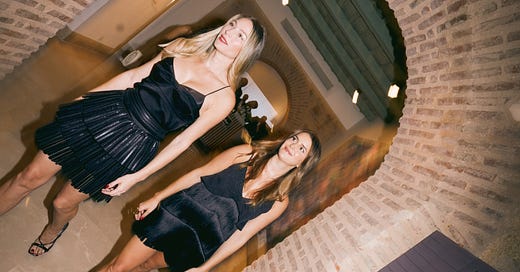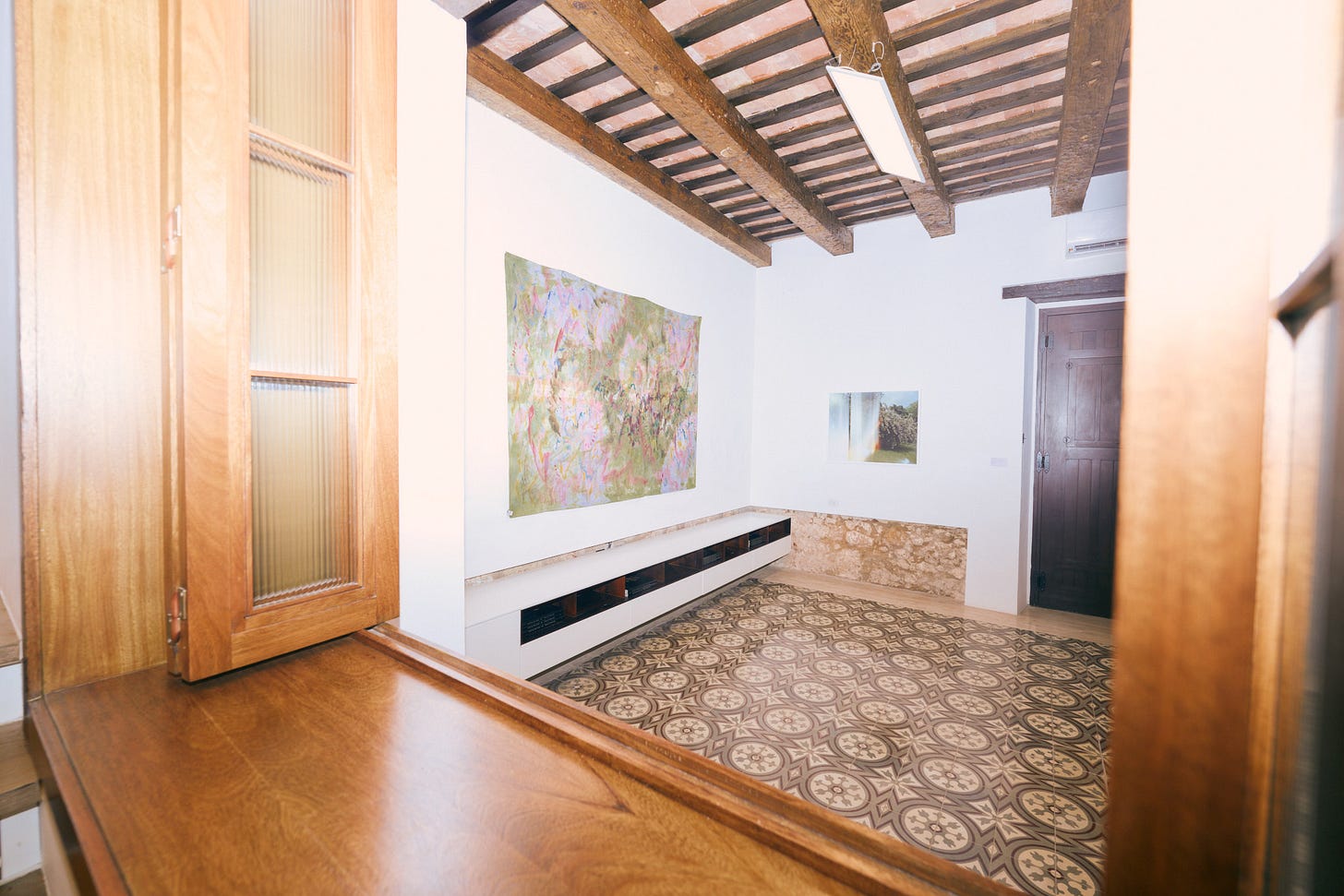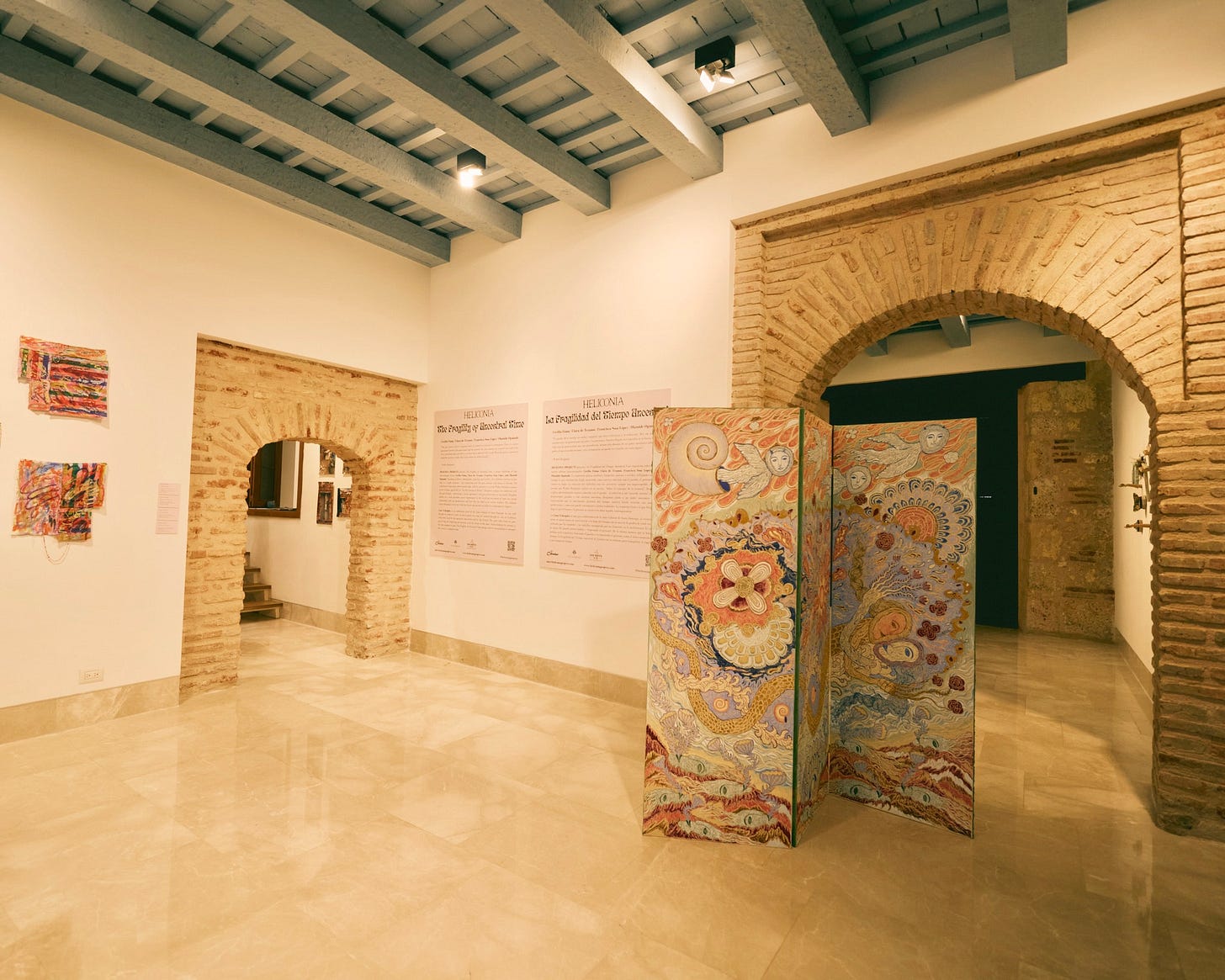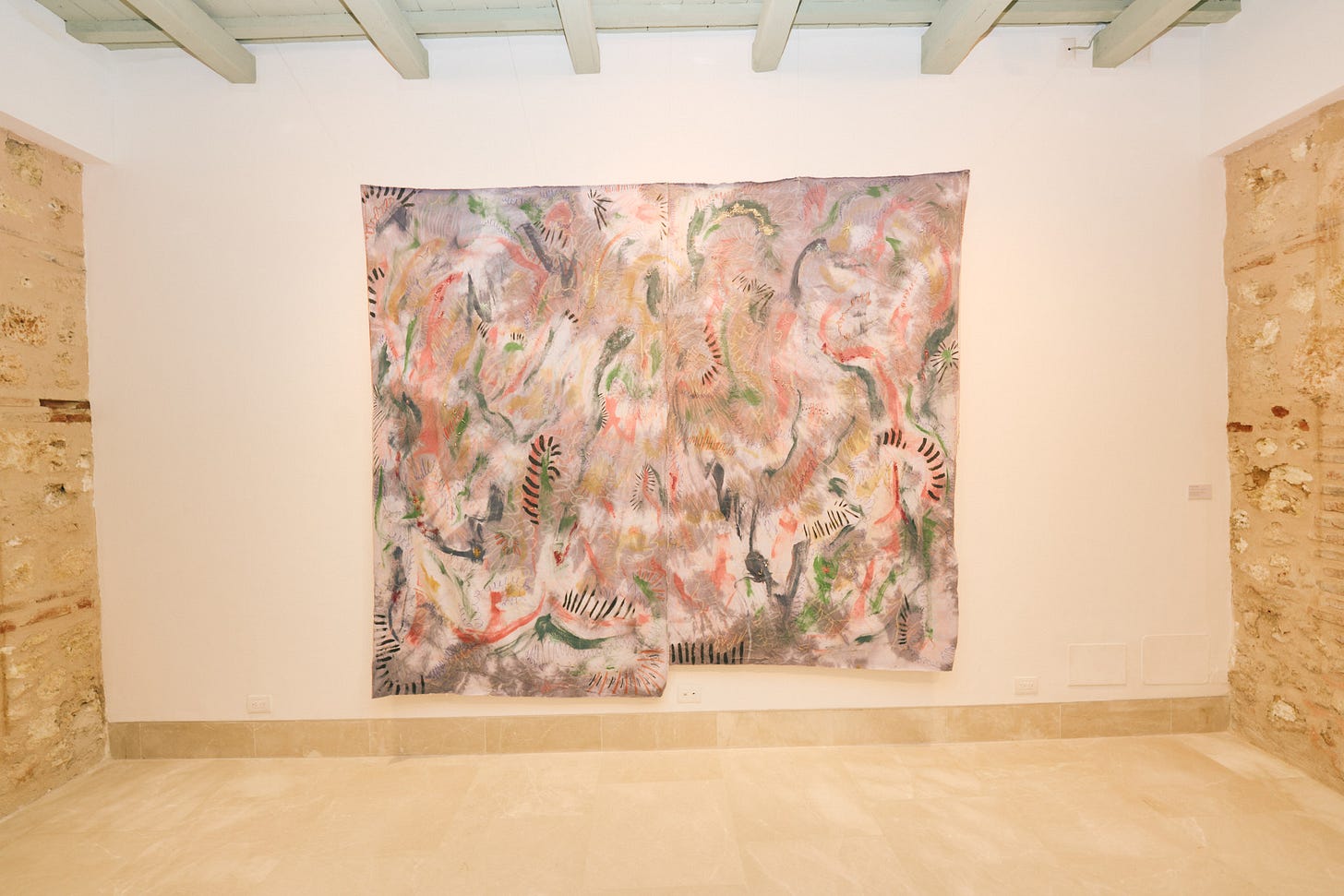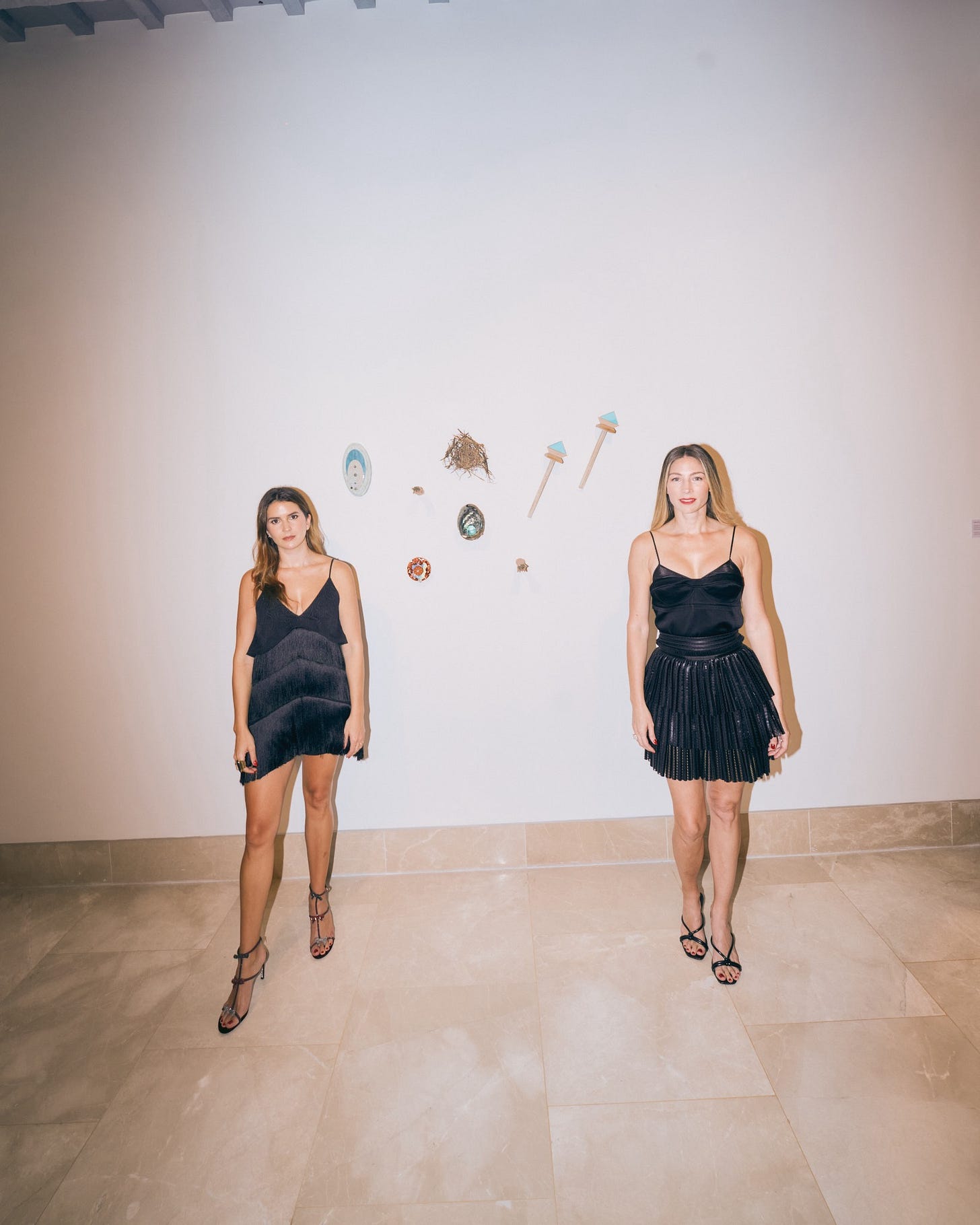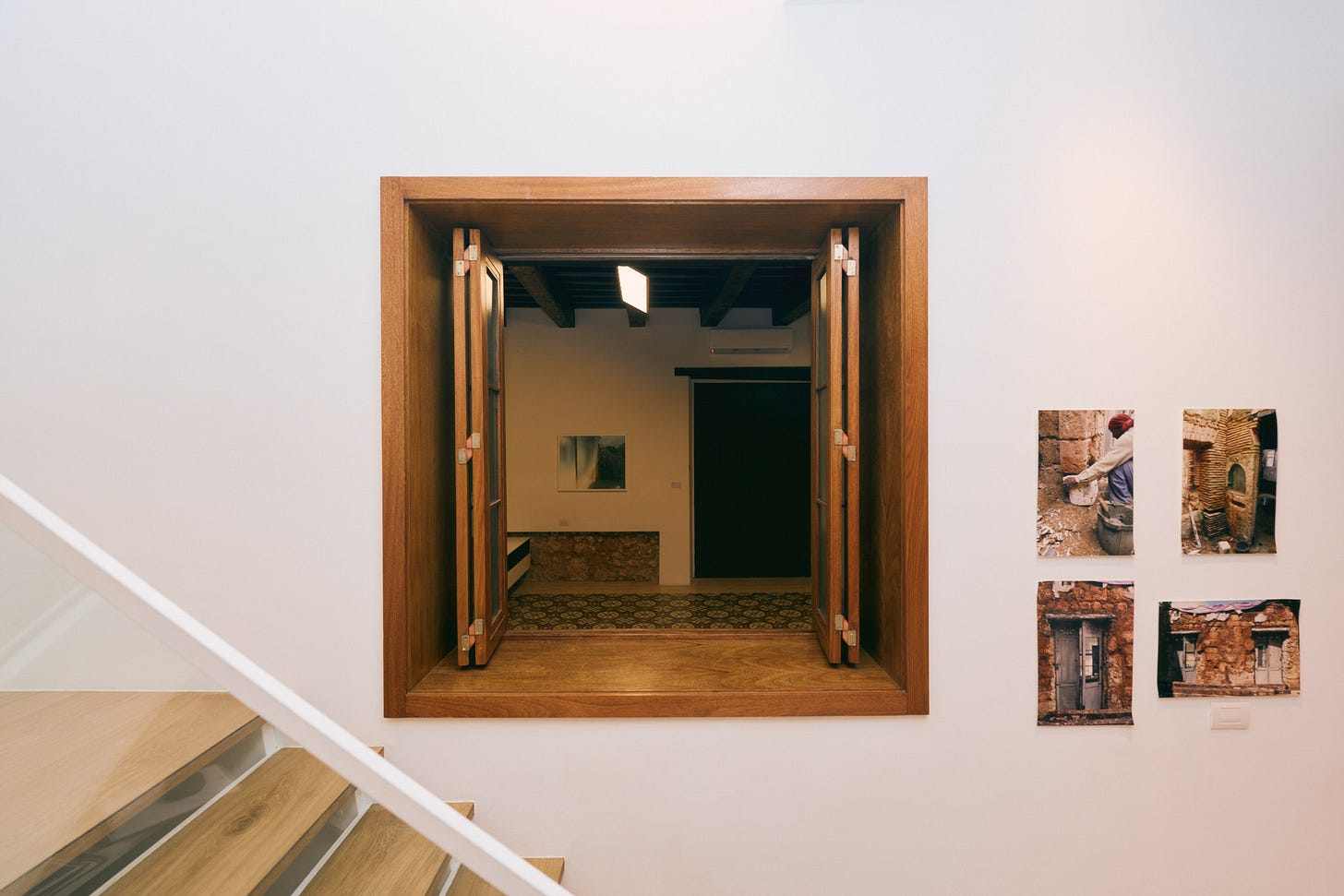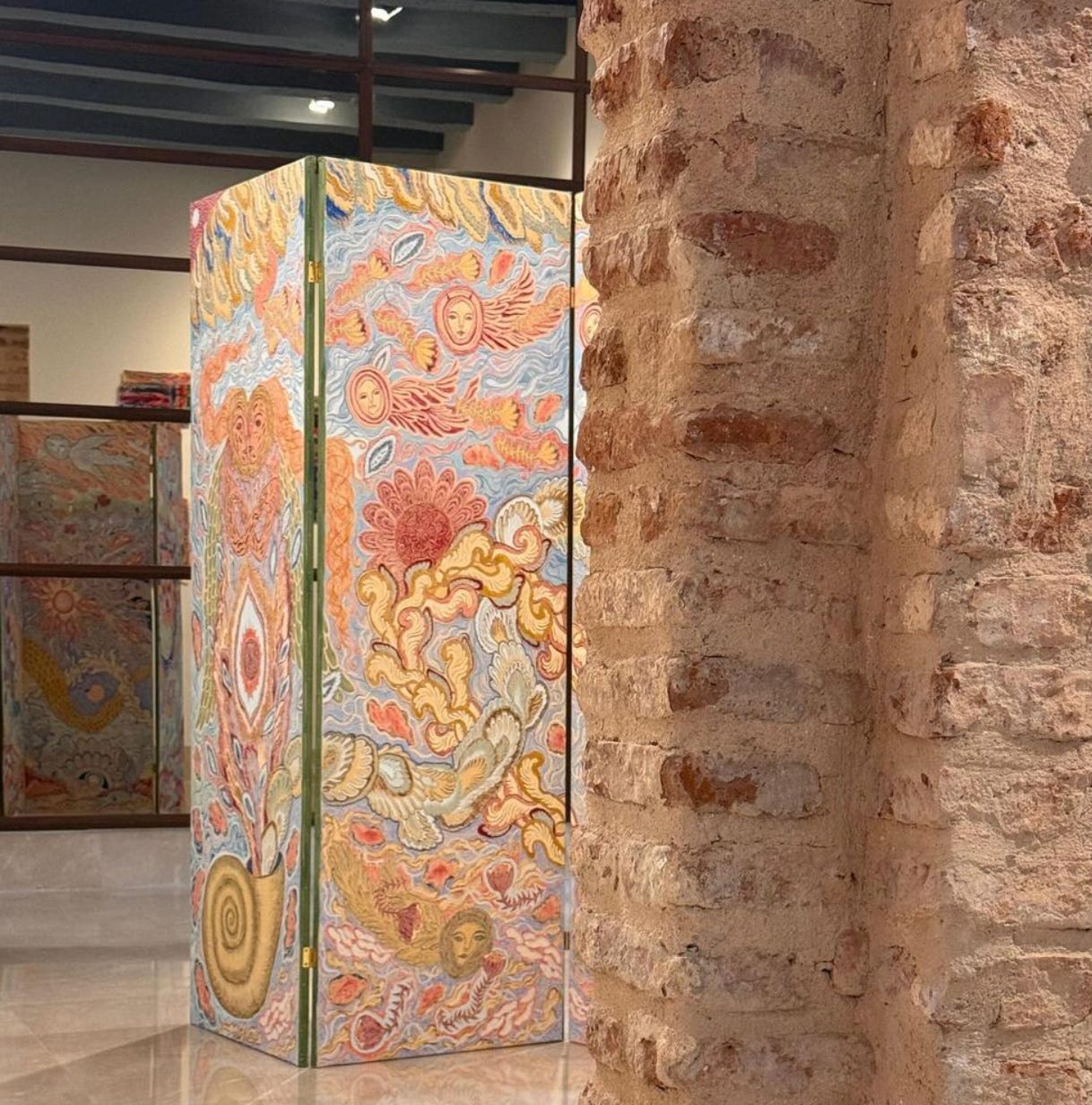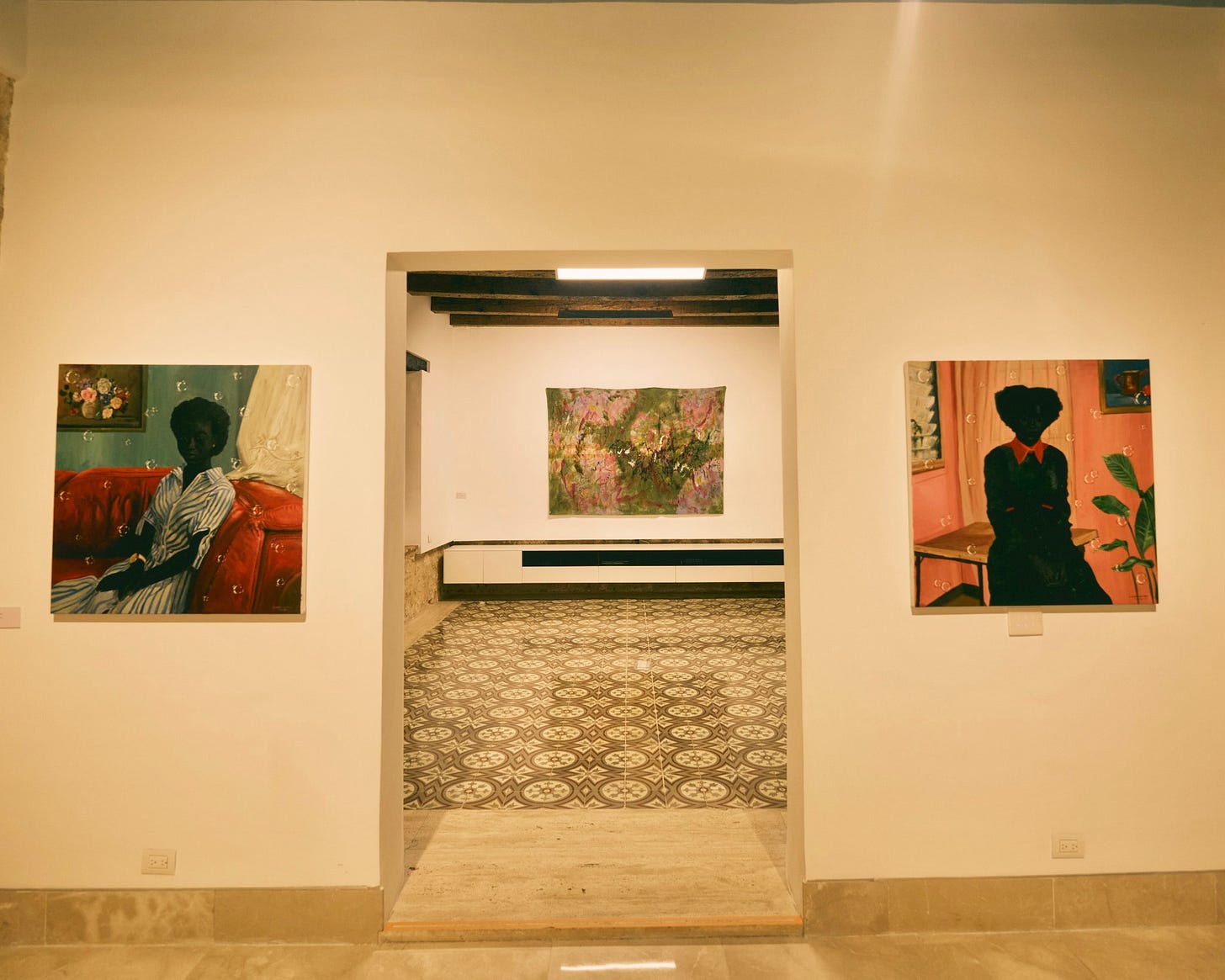In conversation with: Heliconia Projects
En conversación con: Heliconia Projects (versión en español abajo)
Heliconia Projects is a nomadic gallery and curatorial platform, founded by Nicole Bainov and Elsa Maldonado, two Dominican Republic based collectors driven by their deep love for art and commitment to nurturing connections and community through culture. In this interview, Nicole and Elsa open us the doors to their lives and their gallery, showing us their remarkable contributions to the arts scene emerging from this vibrant region.
Q: Tell us about yourselves and how you decided to start Heliconia Projects.
Elsa: Nicole and I met here, in the Dominican Republic. I used to live in the United States and Nicole in London, but it has already been three years since both of us live here. How we met was one of those coincidences that are not coincidences in life. Nicole went to visit a house and the owner of the place was my uncle. He asked Nicole what her name was, and when Nicole told him, my uncle replied: "I know a man with that last name, he was my partner".
Nicole: Well, that partner was my father.
Elsa: Then my uncle tells me: "You have to meet Nicole. She is also fascinated by art and her family is very nice." We arranged to meet and coincidentally, her wedding was in three days. I was her wedding crasher. We are both collectors, so we started sending each other artists we were interested in and loved their practice. From there, we shared it with people we knew, and a very organic art advisory started to emerge. So, we said, "What if we try doing an event or an exhibition?" But we realized we wanted to do more than that.
Nicole: (laughs) I said, "Come to my wedding." When we met, we saw that we had a good synergy between the two of us. We have different tastes in many areas, but similar in art. We were also both very interested in supporting artists and thought about what we can do together with our collective experiences in the art world. We wanted to do something that we could do in different parts of the world, and at the same time take advantage and bring the international art world to the Dominican Republic and bring Dominican artists abroad. We wanted something different, fun, dynamic, breaking the mold of a traditional art gallery. This is how Heliconia Projects was born, an itinerant gallery and curatorial platform.
“We wanted something different, fun, dynamic, breaking the mold of a traditional art gallery”
Q: Why a nomadic gallery?
Elsa: It didn't suit us to lease a permanent space. First, Nicole lives in Santo Domingo, and I live between Punta Cana and Casa de Campo, so there is a difference in geographic location. We also both travel a lot. In the last few years, the Dominican Republic has had an exceptional growth in tourism. In Punta Cana and Casa de Campo, there has been an exponential growth of population and people coming to vacation. So, we wanted to take advantage of the situation the country is experiencing and the boom of the Caribbean worldwide. There is a movement, and it is getting bigger and bigger, but it is not established. The benefit of not having a fixed space is that we can go where our collectors are interested. Also, there is the idea of being able to integrate the space where we do the exhibition as part of the curatorship of the whole program. In the case of our most recent exhibition "The Fragility of Ancestral Time", we chose the artists and the theme, and then we looked for a space that would accommodate that.
Nicole: We want to take advantage of and use different spaces, we want to see more lived art: In a house, in a historical place. Not simply in a "white cube" style. Our exhibitions try to create an interesting dialogue with the space, and precisely "The Fragility of Ancestral Time" achieves that. The place we chose for the exhibition is a 16th century building, which for the Americas is very old. The building has been restored in the most respectful way to its origins, leaving visible traces of its past interventions. We found it really in accordance with the curatorship and the work of the artists exhibiting: Cecilia Fiona, Olamide Ogunade, Francisca Sosa Lopez and Clara de Tezanos, who spend a lot of time questioning the past and how to use it as a way of growth for the present. The building, Casa Velazquez, achieves exactly that, and is an example of why we want to continue to look for places that dialogue with the works we choose and with the artists.
Q: What is the mission of Heliconia Projects?
Elsa: When Nicole and I started this project, we asked ourselves: Why are we doing Heliconia? We both agreed that we are doing it for the artists. The art world would not exist without the artist. Yes, the collector is very important, the galleries are very important. They are all important, but the artist is where everything is created. That's why we also call ourselves "Heliconia", because Heliconia, apart from being the muse of art, is a plant that creates an ecosystem for those around it to nourish themselves. Our goal is to nurture the artists we work with, to introduce them to museums and institutions. We think it is very important.
Nicole: Yes, we know we are a bit far from it because we have just started, but that's why it is important for us to have our mission clear from the beginning. As seen in "The Fragility of Ancestral Time," our exhibitions are quite curatorial, aligned with the vision of a museum. This exhibition was quite immersive, we even had QR codes next to some pieces with the artist's voice explaining their work. For us, it was very important to transmit that feeling, that strength that only the artist can give you when they explains their work. We also played shamanic music, which we consider to be ancestral music. So, when you saw the exhibition, you really felt that everything had a reason and a meaning behind it.
“When Nicole and I started this project, we asked ourselves: Why are we doing Heliconia? We both agreed that we are doing it for the artists”
Q: How do you link the local community and the art scene in the places where you organize exhibitions?
Elsa: It's a challenge, because Nicole and I are not Dominican and we have little time in the country, so we are just getting to know the art community and the art industry here. But I think it is a benefit because by not knowing, we are acting more from our heart, our passion, not thinking about what people will say.
Nicole: We've had a pretty refreshing reception. What people tell us is that what we do feels very authentic, and I think that's because we are new here and we just go by the artists we are attracted to and want to work with. In the Dominican Republic, there is not yet a very marked art scene and that is a great benefit because it opens the doors to many possibilities. Collaboration with other galleries and institutions is also key. We are a small country; we have to collaborate so that we can have a foreign vision. There are so many negative things happening in the world, and art brings so much positivism, so much beauty, inspiration, and healing to everyone, that it is a shame not to share and collaborate with each other in the art world.
“There are so many negative things happening in the world, and art brings so much positivism, so much beauty, inspiration, and healing to everyone, that it is a shame not to share and collaborate with each other in the art world”
Q: How do you select the artists you work with?
Nicole: Some are artists that I have worked with in the past, some are artists that Elsa has worked with in the past. We always study all their work in depth, we look at their resumes, everything. If I have to define it in steps, the first step is to look at the work and connect. If Elsa and I connect, we research who the artist has worked with, their educational and exhibition curriculum, where they are based, what the meaning of their work is, the reason why they produce their work, etc.
Elsa: Nicole and I are interested in artists who have something intellectual behind their work. For example, you could look at Brittany Fanning, who is a very playful artist, but her work is very deep. The last thing is that there has to be a connection between the artist and us. There must be a chemistry between us, we need to feel like they're interested in what we're doing as well. That's key, we want artists who are willing to be part of something different.
“We want artists who are willing to be part of something different”
Q: Can you give us a preview of what's coming up for Heliconia Projects in the next few months?
Nicole: We have the Hotel Warszawa Art Fair in September. The fair is in a super historic hotel in Warsaw, similar to the Felix Art Fair model in Los Angeles. Other than that, we want to have about three exhibitions per year. I think we are going to have three or four this year in total.
Elsa: We prefer to go slowly and be consistent. We want to do things right and build that trust with our collectors that we are here, and we are going to stay. Our intention is to remain grassroots and continue to have super close relationships with artists and collectors.
Nicole: I know that once we grow, things will change. But we always want to have "grow slowly but steadily" as our foundation. We don't want to start doing 15 exhibitions a year, that is not the goal.
“Our intention is to remain grassroots and continue to have super close relationships with artists and collectors”
Q: What is the biggest challenge you have faced since opening Heliconia Projects?
Nicole: Trying to bring everything for our exhibition "The Fragility of Ancestral Time" was quite a challenge. In this exhibition, we had to bring works from London, Nigeria, New York, Venezuela, Copenhagen, and Guatemala. That was difficult, but we succeeded, and we are learning from that experience.
Elsa: For me, one of the most difficult points of doing this project in the Caribbean is the logistics because of its geographical location. Another thing is that I like to be a very private person on social media. I am happy talking directly to artists and collectors, but having to open my world to others on the internet is difficult. Heliconia Projects, in the end, is Nicole and me. So, to build trust, people must get to know us and for that to happen, I have to let them get to know me.
Nicole: Elsa on social media is very authentic. We are not expert influencers, so everything that comes out is really genuine. It's very challenging to step out of your comfort zone in this way.
Q: What advice would you give to emerging artists who would like to work with you?
Nicole: I would say always stay in your authenticity. Despite what people tell you about your work, always do what comes naturally to you. Also grow slowly, more or less what we are doing, step by step. Don't try to go too fast, think of too many things at once and do too many exhibitions. Better to do one really well done exhibition than to have 10 more or less well done ones.
Elsa: I would add to what Nicole said that the artist also has to think like an entrepreneur and know how to sell himself. The more organized, the more methodical and planned you are, the easier it will be for any gallery to want to work with you. That also helps the artist to protect themselves against any situation, it's also good to know how to read a contract, for example. The last one would be to know your value. When you know you are worth, the other knows you are worth. Never give away your work.
To learn more about Heliconia Projects and its founders, visit:
https://heliconiaprojects.com/
Heliconia Projects es una galería nómada y una plataforma curatorial, fundada por Nicole Bainov y Elsa Maldonado, dos coleccionistas radicadas en la República Dominicana impulsadas por su profundo amor por el arte y su compromiso de fomentar las conexiones y comunidad a través de la cultura. En esta entrevista, Nicole y Elsa nos abren las puertas a sus vidas y a su galería, mostrándonos sus notables contribuciones a la escena artística que está surgiendo en esta vibrante región.
Q: Cuéntennos sobre ustedes y cómo decidieron empezar Heliconia Projects.
Elsa: Nicole y yo nos conocimos aquí, en República Dominicana. Yo vivía antes en Estados Unidos y Nicole en Londres, pero ya ambas tenemos tres años viviendo acá. Cómo nos conocimos fue una de esas casualidades que no son casualidades en la vida. Nicole se fue a visitar una casa y el dueño del lugar era mi tío. Él le pregunta a Nicole cuál es su nombre, y Nicole al decirle, mi tío le responde: “Yo conozco a un señor con ese apellido, era mi socio.”
Nicole: Pues ese socio era mi papá.
Elsa: Entonces mi tío me dice: “Tienes que conocer a Nicole. También le fascina el arte y su familia es muy linda.” Quedamos en vernos y coincidentemente, su boda era en tres días. Fui su “wedding crasher”. Ambas somos coleccionistas, entonces empezamos a mandarnos artistas que nos interesaban y amábamos su práctica. De ahí, se lo compartíamos a gente que conocíamos y fue surgiendo una asesoría de arte muy orgánica. Así que dijimos: “¿Y si probamos hacer un evento o una exhibición?” Pero, nos dimos cuenta de que queríamos hacer más que eso.
Nicole: (risas) Yo le dije: “Ven a mi boda.” Cuando nos conocimos, vimos que teníamos una sinergia muy buena entre las dos. Tenemos gustos diferentes en muchos ámbitos, pero similares en arte. A ambas también nos interesaba mucho apoyar a los artistas y pensamos qué podemos hacer juntas con nuestras experiencias colectivas en el mundo del arte. Queríamos hacer algo que podíamos hacer en diferentes partes del mundo, y al mismo tiempo aprovechar y traer el mundo internacional del arte a la República Dominicana y llevar a artistas dominicanos al exterior. Queríamos algo diferente, divertido, dinámico, rompiendo el molde de una galería de arte tradicional. Así nació Heliconia Projects, una galería itinerante y plataforma curatorial.
“Queríamos algo diferente, divertido, dinámico, rompiendo el molde de una galería de arte tradicional”
Q: ¿Por qué una galería nómada?
Elsa: No se acomodaba a nosotras el alquilar un espacio permanente. Primero, Nicole vive en Santo Domingo y yo entre Punta Cana y Casa de Campo, entonces hay una diferencia de ubicación geográfica. En los últimos años, República Dominicana ha tenido un crecimiento turístico excepcional. En Punta Cana y Casa de Campo, ha habido un crecimiento exponencial de población y de gente que viene a vacacionar. Entonces, queríamos aprovechar la situación que el país está viviendo y el “boom” del Caribe a nivel mundial. Hay un movimiento y cada vez es más grande, pero no está establecido. El beneficio de no tener un espacio fijo es que podemos ir a donde están nuestros coleccionistas interesados. También, tenemos la idea de poder integrar el espacio donde hagamos la exhibición como parte de la curaduría de todo el programa. En el caso de nuestra exhibición más reciente “La fragilidad del tiempo ancestral”, escogimos a los artistas y el tema, y luego buscamos un espacio que se acomode a eso.
Nicole: Queremos aprovechar y usar espacios diferentes, queremos ver arte más vivido: En una casa, en un lugar histórico. No simplemente en un estilo “White cube”. Nuestras exhibiciones tratan de crear un diálogo interesante con el espacio, y precisamente “La fragilidad del tiempo ancestral” logra eso. El lugar que escogimos para la exhibición es un edificio del siglo XVI, que para las Américas es muy antiguo. El edificio ha sido restaurado de la manera más respetuosa a sus orígenes, dejando visibles los rastros de sus intervenciones pasadas. Nos pareció super de acorde con la curaduría y el trabajo de los artistas que exhibían: Cecilia Fiona, Olamide Ogunade, Francisca Sosa López y Clara de Tezanos, que pasan mucho tiempo cuestionando el pasado y cómo usarlo como forma de crecimiento para el presente. El edificio, Casa Velazquez, logra exactamente eso, y es una muestra de porque queremos seguir buscando lugares que dialoguen con las obras que escogemos y con los artistas.
Q: ¿Cuál es la misión de Heliconia Projects?
Elsa: Cuando Nicole y yo empezamos este proyecto, nos preguntamos: ¿Por qué estamos haciendo Heliconia? Las dos coincidimos que lo estamos haciendo por el artista. El mundo del arte no existiría sin el artista. Sí, el coleccionista es muy importante, las galerías son muy importante. Todos son importantes, pero con el artista es donde nace todo. Por eso también nos llamamos “Heliconia”, porque Heliconia, aparte de ser la musa del arte, es una planta que crea un ecosistema para que los que están alrededor se vayan nutriendo. Nuestra meta es nutrir a los artistas con quien trabajamos, introducirlos a museos y a instituciones. Nos parece súper importante.
Nicole: Sí, sabemos que estamos algo lejos de ella porque acabamos de empezar, pero por eso para nosotros es importante tener nuestra misión clara desde el inicio. Como se ve en “La fragilidad del tiempo ancestral,” nuestras exhibiciones son bastante curatoriales, alineadas con la visión de un museo. Esta exhibición fue bastante inmersiva, incluso teníamos códigos QR junto a algunas piezas con la voz del artista explicando su obra. Para nosotras, era sumamente importante transmitir esa sensación, esa fortaleza que solo el artista te puede dar cuando explica su obra. También pusimos música chamánica, que consideramos como música ancestral. Entonces, realmente al ver la exhibición sentías que todo tenía un por qué y un sentido.
“Cuando Nicole y yo empezamos este proyecto, nos preguntamos: ¿Por qué estamos haciendo Heliconia? Las dos coincidimos que lo estamos haciendo por el artista”
Q: ¿Cómo vinculan a la comunidad local y la escena artística de los lugares donde organiza las exposiciones?
Elsa: Es todo un reto, porque Nicole y yo no somos dominicanas y tenemos poco tiempo en el país, entonces estamos empezando a conocer la comunidad artística y la industria del arte aquí. Pero, yo creo que es un beneficio porque al no saber, estamos actuando más desde nuestro corazón, nuestra pasión, sin pensar en el qué dirán.
Nicole: Hemos tenido una recepción bastante fresca. Lo que la gente nos dice es que lo que hacemos se siente muy auténtico, y creo que eso es gracias a que somos nuevas acá y simplemente nos guiamos por los artistas que nos atraen y con los que queremos trabajar. En la República Dominicana, todavía no hay una escena artística muy marcada y eso es un beneficio grandísimo porque abre las puertas a muchas posibilidades. La colaboración con otras galerías e instituciones es clave también. Somos un país pequeño, tenemos que colaborar para para que podamos tener visión extranjera. Hay tantas cosas negativas pasando en el mundo, y el arte trae tanto positivismo, tanta belleza, inspiración y sanación a cualquier persona, que es una pena no compartir y colaborar entre nosotros en el mundo del arte.
“Hay tantas cosas negativas pasando en el mundo, y el arte trae tanto positivismo, tanta belleza, inspiración y sanación a cualquier persona, que es una pena no compartir y colaborar entre nosotros en el mundo del arte”
Q: ¿Cómo seleccionan a los artistas con los que trabajan?
Nicole: Algunos son artistas con quien yo he trabajado en el pasado, otros son artistas con quien Elsa ha trabajado en el pasado. Siempre estudiamos a profundidad toda su obra, miramos sus currículos, todo. Si tengo que definirlo en pasos, el primero es ver la obra y conectar. Si Elsa y yo conectamos, investigamos con quién el artista ha trabajado, dónde esta establecido, cuál es el significado de su trabajo, la razón del por qué producen su obra, etc.
Elsa: Nicole y yo estamos interesadas en artistas que tienen algo intelectual detrás de su obra. Por ejemplo, podrías ver a Brittany Fanning, que es una artista muy divertida, pero su obra es súper profunda. Lo último es que tiene que haber una conexión entre el artista y nosotras. Tiene que haber una química entre nosotros, necesitamos sentir que les interesa lo que nosotras estamos haciendo también. Eso es clave, queremos artistas que están dispuestos a ser parte de algo diferente.
“Queremos artistas que están dispuestos a ser parte de algo diferente”
Q: ¿Nos pueden adelantar que se viene para Heliconia Projects en los siguientes meses?
Nicole: Tenemos el Hotel Warszawa Art Fair en septiembre. La feria es en un hotel súper histórico en Varsovia, parecido al modelo de Felix Art Fair en Los Ángeles. Aparte de eso, queremos tener aproximadamente tres exhibiciones este año. Yo creo que vamos a lograr tres o cuatro.
Elsa: Preferimos ir despacio y ser constantes. Queremos hacer las cosas bien e ir creando esa confianza con nuestros coleccionistas de que estamos aquí y nos vamos a quedar. Nuestra intención es permanecer “grassroots” y seguir teniendo relaciones súper cercanas con los artistas y los coleccionistas.
Nicole: Yo sé que una vez que crezcamos, las cosas van a cambiar. Pero, siempre queremos tener como nuestra base “crecer lento, pero bien”. No queremos empezar haciendo 15 exposiciones por año. Para nosotras, esa no es la meta.
“Nuestra intención es permanecer “grassroots” y seguir teniendo relaciones súper cercanas con los artistas y los coleccionistas”
Q: ¿Cuál es el mayor reto al que se han enfrentado desde que abrieron Heliconia Projects?
Nicole: Tratar de traer todo para nuestra exhibición “La fragilidad del tiempo ancestral” fue todo un reto. En esta exposición, tuvimos que traer las obras desde Londres, Nigeria, Nueva York, Venezuela, Copenhagen y Guatemala. Fue difícil, pero lo logramos y estamos aprendiendo de esa experiencia.
Elsa: Para mí, uno de los puntos más difíciles de hacer este proyecto en el Caribe es la logística por su ubicación geográfica. Otra cosa es que me gusta ser una persona muy privada en redes sociales. Yo soy feliz hablando directamente con los artistas y con los coleccionistas, pero el tener que abrir mi mundo a los demás en internet es difícil. Heliconia Projects, al final, somos Nicole y yo. Entonces, para crear confianza, la gente nos tiene que conocer y para que eso suceda, tengo que dejar que me conozcan.
Nicole: Elsa en redes sociales es muy auténtica. Nosotras no somos “influencers” expertas, entonces todo lo que sale es de verdad genuino. Es muy retador salir de tu zona de confort de esta manera.
Q: ¿Qué consejo le podrían dar a artistas emergentes que quisieran trabajar con ustedes?
Nicole: Yo diría siempre quédate en tu autenticidad. A pesar de lo que te dicen de tu obra, siempre haz lo que te viene naturalmente. También crecer lentamente, más o menos lo que estamos haciendo nosotras, paso por paso. No tratar de ir demasiado rápido, pensar en demasiadas cosas a la vez y hacer demasiadas exhibiciones. Mejor hacer una exhibición súper bien hecha que tener 10 más o menos bien.
Elsa: Yo agregaría a lo que dijo Nicole que el artista también tiene que pensar como empresario y saberse vender. Mientras más organizado, más metódico y planeado seas, más fácil será para cualquier galería querer trabajar contigo. Eso también ayuda al artista a protegerse frente a cualquier situación, es bueno también saber cómo leer un contrato, por ejemplo. La última seria que sepan su valor. Cuando tú sabes que tú vales, el otro sabe que tú vales. Nunca regales tu trabajo.
Para saber más sobre Heliconia Projects y sus fundadoras, visita:


